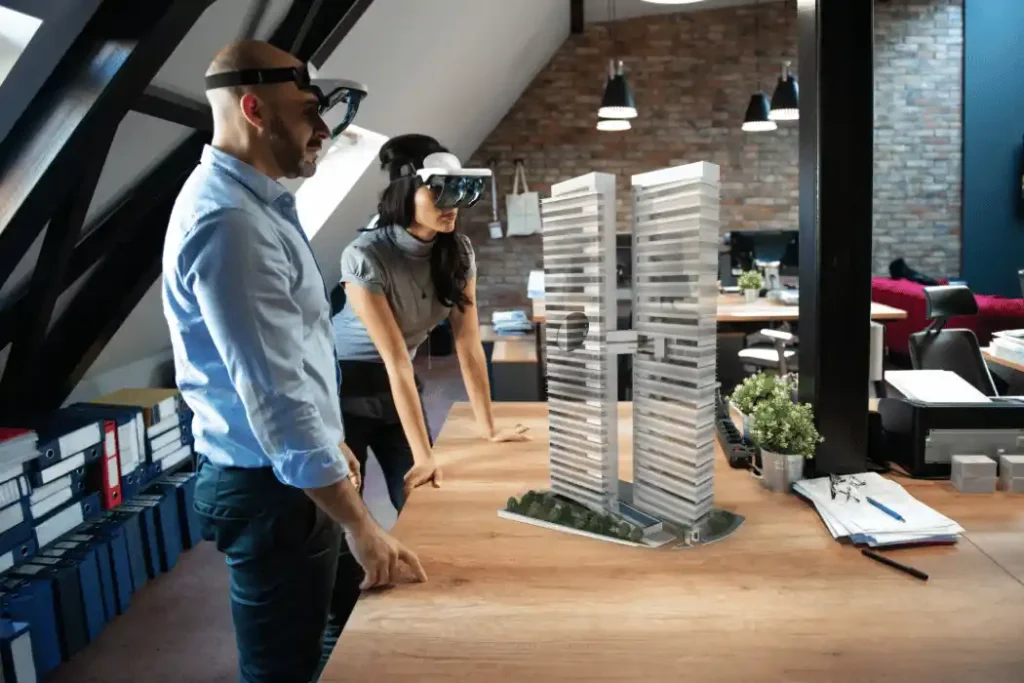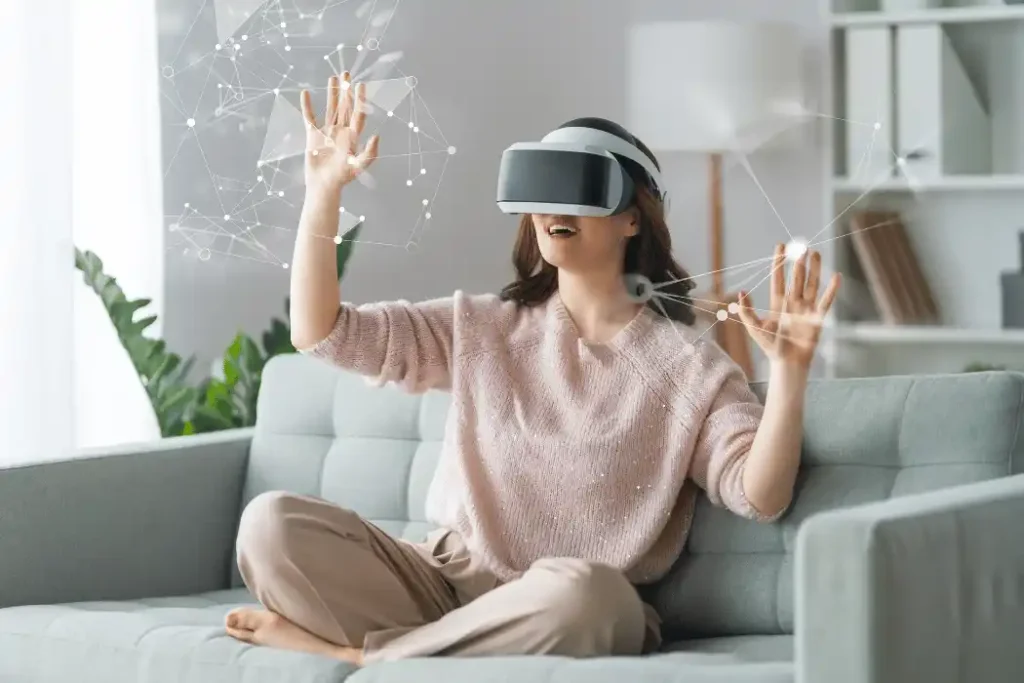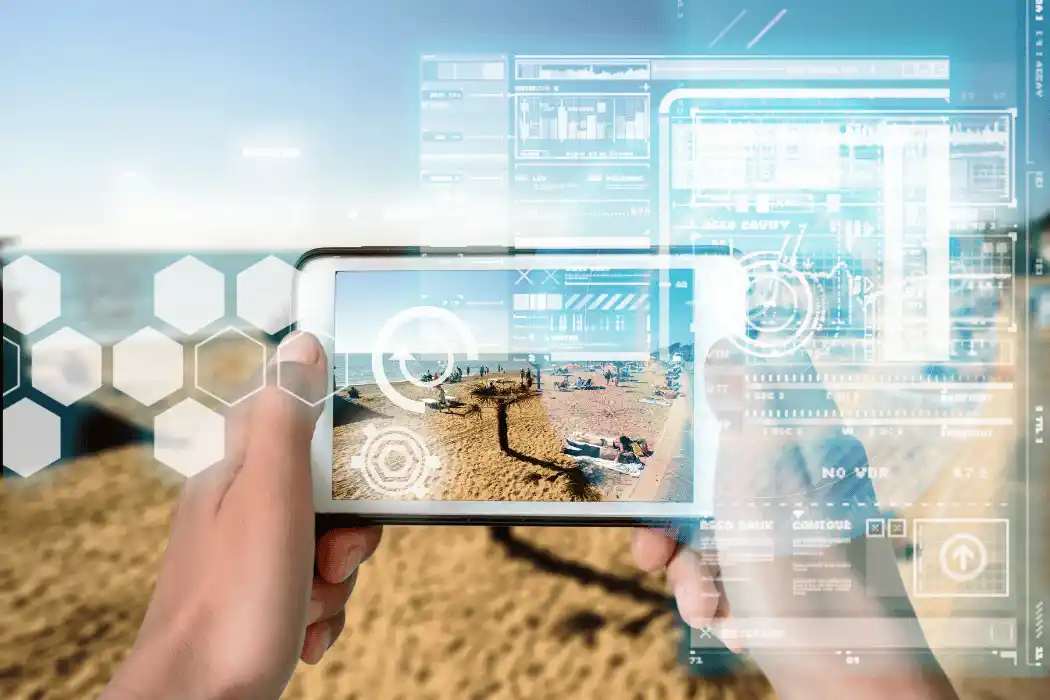Augmented reality, once primarily associated with playful applications like Pokemon Go and Snapchat filters, has undergone a dramatic transformation. What began as a novel form of entertainment has rapidly matured into a robust business tool. In 2024, tech is no longer confined to the realm of fun and games; it is now a cornerstone of innovative strategies across industries, demonstrating its immense potential to revolutionize operations, enhance customer experiences, and drive growth.
Let’s explore the 12 augmented reality trends driving innovation in 2024 and uncover how they can be leveraged to propel your business forward.
Read more about Innovations in Remote Work.
Trend 1: AI Drives the Future of Augmented Reality
Artificial intelligence has been an indispensable partner in the evolution of augmented reality. Its prowess in tasks such as facial and spatial recognition surpasses traditional algorithmic approaches. But the synergy between AI and AR is deepening. In 2024, AI is not merely a tool for interpreting sensor data; it’s becoming a catalyst for creating truly immersive and interactive augmented experiences. Let’s explore the key roles AI is playing in enhancing AR capabilities:
Crafting Lifelike Digital Representations: AI is revolutionizing how AR perceives and reproduces the physical world. Beyond basic facial recognition, it can now construct intricate, 3D models of human faces and objects. This capability is transforming the way we interact with AR, enabling the creation of highly realistic avatars and immersive virtual environments.
Intelligent Object Recognition and Placement: AI-powered machine vision excels at identifying and categorizing real-world objects. But its application extends far beyond simple labeling. By accurately recognizing objects in a scene, AR experiences can seamlessly integrate virtual elements, creating interactive and engaging augmented realities.
Real-Time Text Translation: AR, powered by AI, can instantly translate text captured by a camera. This feature eliminates language barriers, making information accessible on the fly.
The advent of generative AI models, exemplified by ChatGPT, is poised to revolutionize augmented reality. Tools like Spline are already harnessing the power of natural language processing and generative AI to create and manipulate complex 3D objects with unprecedented ease. From intricate textures to dynamic animations, the possibilities are vast and exciting.

AI Enhances AR Device Setup and Troubleshooting
At MobiDev, we’ve been exploring the transformative potential of merging AR and AI to address contemporary business challenges. A prime example is our innovative proof-of-concept for Wi-Fi router onboarding and troubleshooting. By leveraging smartphone cameras, users can access step-by-step setup guidance and effortlessly diagnose common issues through intuitive 3D visual instructions delivered in augmented reality. This groundbreaking application harnesses the power of AI and AR to streamline several key tasks, including:
- Router Self-Detection
- Determining if Cables Need to Be Connected to the Router
- Interpreting the Router’s Front Lights to Assess Device Status
While AR remote assistance tools offer valuable support, our solution distinguishes itself by eliminating the need for human intervention beyond the end-user.
Trend 2: Advancing into the Metaverse with AR Technologies
While the initial metaverse frenzy has cooled, its core technologies continue to evolve. The concept was initially intertwined with decentralization, cryptocurrencies, and blockchain. However, these elements have taken a backseat as the focus shifts to more tangible and practical applications. Augmented reality, often seen as a cornerstone of the metaverse, has emerged as a stable and promising technology. Devices like Apple’s Vision Pro exemplify the immense potential of AR in shaping the future.
Realistic Avatars: Connecting the Real and Virtual Worlds
Social augmented reality is evolving from cartoonish representations to strikingly realistic avatars. This shift towards hyperrealism promises more natural and immersive interactions. Apple’s Vision Pro offers a glimpse into this future, showcasing technology that brings digital personas closer to life-like authenticity.
Apple’s Spatial Personas are the next evolution of avatars, utilizing machine learning to capture and replicate human-like body language and facial expressions with unprecedented accuracy. These lifelike digital representations are designed to enhance social AR/VR interactions on platforms like FaceTime, creating a more immersive and natural sense of connection.
Apple isn’t the sole pioneer in this space. Meta is concurrently developing a similar concept termed Codec Avatars. To expedite the creation of these lifelike 3D faces, they’ve constructed a specialized deep generative model. By automating this complex process, Meta is significantly increasing the accessibility of realistic avatars for the general public.
Trend 3 — Mobile Augmented Reality: Expanding from Games to Business Applications
Mobile augmented reality has transformed from a novelty into a powerful business tool. Once primarily used for entertainment, it now serves as an indispensable technology for navigating complex tasks and analyzing environments. Businesses are increasingly leveraging mobile AR to streamline operations, enhance customer experiences, and drive efficiency through applications such as remote assistance, training, and product visualization.
New Android AR Features in ARCore
Google is expanding the capabilities of ARCore this year with the introduction of Streetscape Geometry. Building upon its 2022 geospatial API, ARCore now provides detailed 3D information about buildings and terrain within a 100-meter radius. This breakthrough enables developers to create AR experiences that seamlessly integrate with the real world, allowing for more interactive and immersive applications.
Rooftop Anchors: ARCore’s new Rooftop Anchors feature allows digital objects to be precisely positioned on real-world rooftops. By utilizing accurate building height and geometry data, these anchors ensure that virtual content aligns perfectly with physical structures.
Geospatial Depth: Leveraging Streetscape Geometry data, ARCore’s Geospatial Depth feature generates a 65-meter depth map by combining it with the depth sensor capabilities of the user’s smartphone. This innovative function provides a more accurate and detailed understanding of the surrounding environment.
Google is expanding ARCore’s reach beyond Android. By introducing the Scene Semantics API on iOS devices, Google is positioning ARCore as the world’s most comprehensive cross-platform augmented reality platform. This strategic move allows developers to create AR experiences that can seamlessly function across different operating systems.
ARKit 6: The Pinnacle of AR Technology for iOS Devices
Apple’s ARKit continues to push the boundaries of augmented reality. Recent updates have introduced several cutting-edge features that enhance the platform’s capabilities and create even more immersive experiences.
- 4K Video Capture during ARKit sessions
- LiDAR Scanner Depth API
- Instant AR Enabled by LiDAR Sensor Plane Detection
- Motion and Pose Tracking
ARKit 6 brings significant improvements to RoomPlan, a feature that utilizes LiDAR technology to rapidly generate accurate floor plans using iPhone or iPad. By leveraging this advanced capability, ARKit empowers developers to build sophisticated AR measurement tools.
ARCore vs ARKit
The primary distinction between ARCore and ARKit lies in hardware, not software. While some high-end Android devices rival the capabilities of newer LiDAR-equipped iPhones, they are exceptions rather than the rule. The vast diversity of Android hardware configurations presents significant challenges in developing consistently robust and immersive AR experiences across the entire ecosystem. In contrast, Apple’s tightly controlled hardware ecosystem provides a more standardized platform for AR development.
Apple’s ecosystem isn’t entirely homogenous either. While boasting advanced features, not all Apple devices are equipped with LiDAR scanners. These high-precision depth sensors are typically reserved for the Pro models of iPhones and iPads, significantly enhancing AR capabilities. Devices lacking LiDAR will inherently deliver less sophisticated AR experiences.

Trend 4 WebAR: Creating Accessible Augmented Reality Experiences
While mobile AR has shown impressive growth, its reliance on high-end hardware limits its accessibility. The most captivating AR experiences often require devices with advanced capabilities, placing them out of reach for most users. In contrast, WebAR offers a more inclusive approach. By delivering simpler AR experiences directly through web browsers, it can be enjoyed on a wider range of devices, making augmented reality accessible to a significantly larger audience.
While WebAR experiences may not match the visual fidelity of native mobile AR applications, its accessibility is a game-changer. By enabling features like face filters, hair color changes, background replacements, and simple 3D objects on virtually any device, WebAR democratizes augmented reality, making it available to a massive audience without requiring app downloads or specific hardware specifications.
The convergence of AI and WebAR is reshaping the digital landscape. Platforms like 8th Wall are at the forefront of this revolution, introducing groundbreaking features that empower developers to create truly immersive web-based experiences. By leveraging AI-generated imagery and enabling shared AR interactions, these advancements are blurring the lines between the physical and virtual worlds.
Trend 5: Cross-Platform AR Applications
A primary objective for many businesses is to reach the widest possible audience with their augmented reality experiences. However, several obstacles hinder this goal:
Diverse Platforms and Devices: The AR landscape is fragmented, with different platforms offering varying capabilities and limitations. Additionally, users possess a wide range of devices, further complicating the development of universally accessible AR experiences.
High Development Costs: Creating native AR experiences for each platform is resource-intensive, demanding significant financial investments and specialized teams to maintain consistency across different environments.
Limited Performance: Cross-platform AR development tools often compromise on performance and visual quality compared to their native counterparts.
Cross-platform AR development is suitable for simpler applications, where reaching a broad audience quickly outweighs performance demands. For more complex AR experiences requiring optimal performance and advanced features, native development remains the preferred choice.
For instance, consider an online store primarily focused on product sales, with a simple AR product preview as a supplementary feature. In this case, a cross-platform AR solution might suffice as the core functionality is platform-agnostic and performance demands are relatively low. However, for applications heavily reliant on platform-specific features or demanding high-performance capabilities, such as 3D scanning or complex AR navigation, native development is the optimal choice. These projects often require deep integration with device hardware and software, which is best achieved through native development.
Trend 6: Wearable Augmented Reality Experiences Have Arrived
The wearable augmented reality landscape has undergone a dramatic shift in recent years. Apple’s highly anticipated Vision Pro marks a pivotal moment in the industry, signaling a significant leap forward in consumer-focused AR headsets. Despite its premium price point, the device represents a groundbreaking achievement and sets a new benchmark for the future of the technology.
Wearable augmented reality is redefining how we interact with technology. By projecting virtual screens and applications into our physical environment, these devices liberate us from traditional display constraints. Imagine transforming any space into a personal cinema or seamlessly accessing computer applications from anywhere. To fully harness the potential of this new paradigm, spatial computing is essential. It enables us to interact with these virtual elements intuitively, creating a more natural and immersive user experience.
Meta has significantly advanced the consumer AR market with the Quest 3 and Quest Pro. These headsets feature full-color passthrough capabilities, offering users affordable access to mixed reality experiences. A prime example of this is PianoVision, a unique app that leverages AR to enhance piano learning. By combining virtual elements like 3D notes and labeled keys with the physical piano, PianoVision provides an innovative approach to musical education.
Apple Vision Pro and the Future of Augmented Reality
Apple’s Vision Pro stands out as a groundbreaking leap in AR/VR technology. Equipped with cutting-edge features like high-resolution displays, advanced sensors, immersive spatial sound, and intuitive eye and gesture tracking, it presents a compelling vision for a highly functional business tool.
Retailers can revolutionize the shopping experience with Vision Pro by showcasing products in immersive 3D environments. This technology enables customers to virtually interact with items, examining them from every angle and even trying them on, fostering a deeper connection with the product. By providing such an engaging and informative pre-purchase experience, retailers can significantly enhance customer satisfaction and drive sales.
Apple’s Vision Pro development ecosystem is centered around the visionOS SDK. This toolkit empowers developers to leverage familiar Apple frameworks like SwiftUI, RealityKit, and ARKit to craft innovative applications for this groundbreaking platform. Existing apps can also be adapted to Vision Pro using the SDK, although the extent of modifications will vary depending on the app’s complexity. While much of the existing codebase can be repurposed, developers should anticipate necessary adjustments and thorough testing to ensure optimal performance and user experience on Vision Pro.
By merging ARKit and VisionOS, developers unlock advanced capabilities such as precise skeletal hand tracking and enhanced accessibility options. This empowers users to intuitively interact with virtual content through a combination of eye movements, voice commands, head gestures, and hand gestures. Developers with a background in ARKit and iOS app development will find a smooth transition to creating immersive experiences for Apple Vision Pro.
The potential of augmented reality on affordable mixed reality headsets is vast and exciting, though still in its early stages. Significant advancements are being made, paving the way for a future where immersive digital experiences are accessible to everyone.
Trend 7: AR Revolutionizes Marketing
Augmented reality offers a wealth of opportunities for marketers to create unforgettable experiences. From simple yet impactful applications like AR business cards and interactive manuals to immersive product demonstrations, the possibilities are endless. AR provides a unique platform to differentiate your brand and captivate your audience. Our team at MobiDev has harnessed the power of ARKit to develop groundbreaking AR business card prototypes, showcasing the potential of this technology.
To illustrate another application, we developed an AR user guide for a coffee machine. This innovative solution enhances user understanding of the device’s operation. This concept can be extended to create interactive manuals for a wide range of products and services.
Augmented reality is proving to be a lucrative tool for businesses. AR Insider predicts that global AR revenue will skyrocket to a staggering $39.8 billion by 2027, underscoring the technology’s immense potential to drive growth.
The Future of Augmented Reality Innovation
The AR and VR market is experiencing explosive growth, surging from a valuation of $15.3 billion in 2020 to a projected $198 billion by 2025 (Statista). This rapid expansion is fueled by a growing consumer demand, with 70% of consumers recognizing the potential benefits of AR (ISACA report). Businesses are actively responding to this trend, investing in AR technologies to meet consumer expectations and drive market growth.
The convergence of augmented reality and artificial intelligence is undeniable. While AI’s current popularity may wane over time, its enduring impact on advancing AR experiences is assured. Beyond its entertainment value, AR has proven to be a robust business tool, and AI will be instrumental in unlocking its full potential across various industries.Partner with seasoned augmented reality developers to bring your vision to life. Ready to embrace the future? Let’s discuss your goals and explore how our expertise can turn your ideas into reality. Contact us today.

